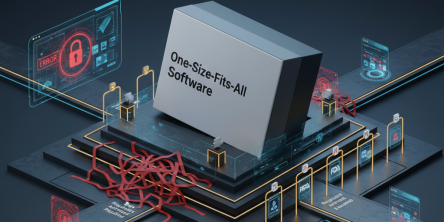Maximizing Licensing Revenue: 5 Ways Royalty Software Empowers Media & Publishing

Let’s be honest – managing royalties isn’t exactly the fun part of working in media or publishing, but it is very important because it protects the creator’s rights and work ownership. That’s especially important now that AI can mimic almost any type of content. Tracking who’s owed what, when, and why can turn into a full-time job, especially if you’re juggling spreadsheets and old-school databases.
But here’s the thing: royalties are a big deal. They're how creators, rights holders, and production partners get paid. When payments are late or wrong, it damages trust and slows things down. That’s where royalty software steps in – and yes, it really can make your life easier.
Let’s go over how it empowers media and publishing, but first, let’s find out what royalties are.
How AI-Generated Content Is Shaking Up Royalties
AI-generated content is changing how royalty management works. From music and books to images and voiceovers, AI tools can now deliver work that mimics, or even incorporates, human-created content.
That raises big questions, such as:
-
Who owns the rights?
-
Who gets paid?
-
How do you track usage across platforms?
Royalty software is starting to adapt by allowing for more granular rights definitions, version tracking, and usage audits. If you're working with or against AI in your creative space, having a system in place to clearly define ownership and track distribution is more important than ever.
Read more: How AI is Disrupting Media & Entertainment to Drive a Better Customer Experience
What Are Royalties, Exactly?
Royalties are the payments made to a person or company when their intellectual property, like music, books, films, or even characters, is used or sold. You calculate it as a percentage of revenue or number of units sold.
Say you're a publisher working with ten authors. Every time one of their books sells, you owe them a cut. Now imagine doing that across different regions, currencies, and licensing terms. That’s a lot to keep up with.
It’s the same with music. According to Statista, the largest source of royalties for music artists in 2019 was TV and radio. It added up to 37% of music royalties collected from broadcasters. So there is a lot of royalties revenue to work with, and your time is limited.
What Is Royalty Software?
Royalty software is a tool that helps you manage the whole royalty process, from contracts to payments. It basically makes your life easier. It can automatically calculate how much is owed, track incoming sales, handle reporting, and keep everything in one place.
Think of it as the difference between using a filing cabinet and having a digital assistant who knows every line of every contract, every sale, and every due date.
5 Ways Royalty Software Makes Your Life Easier
1. It Handles the Problems for You
Royalty math is complicated. Different partners, different splits, multiple currencies, performance clauses – it’s easy to mess something up. Especially when working with a lot of clients and money.
Revenue from royalty collections by European member societies of the International Confederation of Societies of Authors and Composers (CISAC) surpassed €7 billion in 2023, making it a very lucrative industry. One error can mean lost revenue or an angry phone call from a rights holder.
Royalty software takes all those details and does the calculations for you. No more cross-checking sales data and contracts by hand. Everything’s done based on the terms you’ve already set up.
And because the system tracks it all, you can rest easy knowing the numbers are right.
2. You Can Actually See What’s Going On
One of the most frustrating things about old-school royalty management? Not knowing where you stand. How much did a title earn last month? What royalties have gone unpaid? What’s due next quarter?
Royalty software gives you a dashboard that makes it all clear. You can see what’s happening across all your titles and contracts. It's all about real numbers, in real time.
With a good royalty software tool, you get a centralized view of performance, licensing activity, and revenue, all without digging through files or juggling reports.
3. People Get Paid on Time (and That Matters)
Let’s face it, late payments are a bad look. Whether it’s an author, songwriter, or production house, nobody likes chasing down money they’re owed. And as a publisher or media company, you don’t want to be known for dropping the ball.
That’s where a royalty software tool comes in. It keeps track of due dates and payment schedules for you, simplifying your work. Plus, it automates the entire payout process, making sure everything gets handled when it’s supposed to.
This means fewer missed payments, fewer follow-up emails, and better relationships all around.
4. You Don’t Have to Dig for the Info
Things can fall apart fast when your data is scrambled all over the place. Let's say your contract is buried in one folder, your sales reports are in another, and the payment records are somewhere else. What you can do to avoid trouble is automate the entire process.
Royalty software keeps everything in one place: contracts, terms, sales, and payments. You can pull up the info you need in seconds, whether you're answering a partner's question or preparing for a meeting.
With the right software system, you can actually save time working from a dashboard. There, you will find complex licensing structures, territories, and product types.
5. Audits Stop Being a Nightmare
Anyone who's been through a royalty audit knows it’s not fun. Auditors ask for everything – from contracts, reports, to payment history. And if you’re unprepared, it turns into a weeks-long scramble.
Royalty software keeps a full log of everything. That means logging when deals were signed, when payments were made, and how royalties were calculated. So when the audit comes, you're not panicking. You’re ready.
It’s all clean, traceable, and right there when you need it.
Final Thoughts: Time to Make the Switch?
If you're still managing royalties manually, it might feel like you're holding things together with duct tape. And maybe you are, but it doesn't have to be that way.
Royalty software takes the guesswork out of managing complex deals and payments. It keeps your records clean, your partners happy, and your team focused on what actually matters, creating and distributing great content.
Curious about how it actually works? Take a look at available royalties software and see how they help media and publishing teams get things right, the first time.
Similar Articles
It is neither secret nor news that the mind-boggling pace of digital transformation around us has totally altered consumer expectations.
In the world of finance, speed and accuracy are everything. Decisions made a day late can cost millions, and delayed visibility into financial performance can leave even the best organizations blind to risks.
Discover the best tools to enhance employee recognition, boost morale, and create a more motivated, engaged workplace culture.
At first glance, off-the-shelf software appears to be a dream come true. They are quick to set up, cheaper upfront, and marketed as “universal.”
A modern business must continually adapt. This bit everyone seems to know.
The modern healthcare industry is undergoing a significant transformation. The models of healthcare that we are used to thus far are now making way for a more data driven approach
In the modern world, maintaining good health often feels like a constant challenge. Between busy lifestyles, sedentary habits, and lack of motivation, many people find it difficult to stay consistent with exercise, diet, or wellness practices.
Every news publisher's dream, or just getting started, hits that wall sooner or later. What do you build your site on? You’ve basically got two roads: WordPress or custom development.
Discover key features construction teams need in permit tracking software to boost efficiency, stay compliant, and streamline project management.








